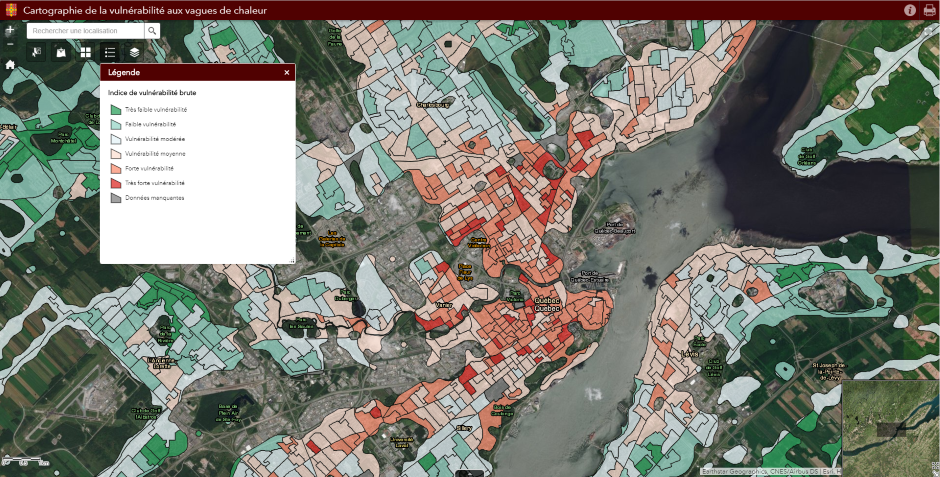Heat waves
Southern Quebec is expected to be particularly affected by heat waves. Major urban centres will see the greatest impact. They are more conducive to heat islands because of their high density of roads and buildings.
The severity of the consequences of heat waves depends on several factors, including:
-
The frequency, both on an annual basis and over several years
-
The duration
-
The intensity, which includes high nighttime temperatures
-
The absence of wind and high humidity
-
The timing, since mortality risks decrease as the summer progresses, largely due to gradual adaptation to the heat
-
The presence of smog in the atmosphere
Health impacts
Heat waves have numerous health impacts, which can sometimes lead to the death of those affected.
The main impacts on physical health are:
-
Heat exhaustion
-
The intensification of pre-existing health conditions, especially associated with diabetes and kidney disorders
-
An increased risk of unintentional injuries
-
An increased risk of hospitalization for cardiovascular or pulmonary diseases
Key impacts on mental health:
-
Increased risks of morbidity and mortality related to dementia, schizophrenia, mood disorders, and suicide
-
A decrease in the happiness and well-being of the population
-
More aggressive behaviours, violent crimes and interpersonal assaults
Learn more about the consequences of heat waves on human health
The effects of heat on the body
Heat has a direct effect on health. It can cause heat stress (cramps, fainting, nausea, headaches, etc.) and cause reactive processes in the body such as dehydration, hyperthermia and heatstroke.
Vulnerable groups of people
Certain groups of people are more vulnerable to heat waves, depending on their health status, exposure to heat, and ability to adapt.
These include:
-
The elderly
-
People experiencing homelessness
-
People with pre-existing health conditions
-
Residents of urban centres
-
Young children
-
Outdoor workers, especially those in construction and agriculture
-
Some indoor workers, especially employees working in kitchens, laundry, welding or foundries, who work on a daily basis in closed environments that are already very hot

Figure 3 : The Géoportail de santé publique du Québec website allows you to visualize the differences between cool islands (in green) and heat islands (in red). The map shows Montréal and the surrounding area.
Source: Géoportail de santé publique du Québec, n.d.
This project focuses on the relationship between summer temperature and the health of workers in five Canadian provinces. It has generated new knowledge that can guide decision-makers and organizations involved in prevention.
This project defined design measures, which, if applied, would significantly reduce the heat island effect generated by parking lots. The normative document it produced should boost innovation and may be referenced by municipalities in their by-laws or tender documents.
Urban heat islands
Urban heat islands are zones where the temperature is much higher than in the surrounding area. They are characterized by a lack of vegetation, impermeable soil, an urban layout and the presence of human activities such as air conditioning and motorized transportation.
The temperature in urban heat islands can be up to 12°C higher than in rural areas, increasing the risk of death during heat waves.
The main heat islands in Quebec are located in metropolitan Montréal and Québec City. Other major cities like Gatineau, Trois-Rivières and Sherbrooke are also facing this problem because of their densely populated and sparsely vegetated downtown areas.
Impacts on infrastructure
Heat waves have consequences for infrastructure, which tend to intensify with increasing temperatures in the context of climate change.
Bridge expansion joints can deteriorate more quickly in the heat, as can other road features designed for adapting to temperature variations. High temperatures can also damage concrete in sewer systems and threaten the integrity of railways by causing metal to expand.
Environmental impacts
Heat waves also have repercussions on ecosystems. High temperatures have an impact on the availability and quality of water. Some plants may therefore lack water. In addition, prolonged heat waves can reduce groundwater levels, for example due to greater extraction at the source for agricultural uses.
High temperatures also promote the proliferation of cyanobacteria, known as blue-green algae. This can have significant consequences on human and animal health when contaminated water is ingested, as well as on various recreational activities and the aesthetics of landscapes.
Heat waves can lead to a decrease in animal and plant populations, especially those of insects that are less adapted to extreme temperatures.
In addition to the direct impact during the heat wave, these populations could decline due to changes in their range. Due to significant temperature changes, some species could decline if they are unable to migrate to cooler regions (in the north) as quickly as temperatures are warming.
Impacts on agriculture
The increase in the intensity and frequency of heat waves will also have impacts on agriculture.
On one hand, hot weather can represent a significant risk for farm animals, affecting their health, well-being, reproduction and development, as well as their egg or milk production, for example.
On the other, crop growth and yields are likely to be lower due to heat waves. In addition, the management of unwanted plant species and harmful insects could become more complex as herbicides and pesticides become less and less effective.
At the same time, it should be noted that agricultural workers face an increased risk to their health due to their exposure to hot temperatures. This can lead to physical and mental health problems, in addition to increasing the number of hours of work lost in the agricultural sector due to extreme weather conditions.
Impacts on the energy sector
Heat waves and extreme heat indirectly impact the energy sector.
Extreme temperatures increase the need for air conditioning, thereby increasing energy consumption. At the same time, the transmission of electricity may be less efficient during intense heat due to the weakening of the cables.